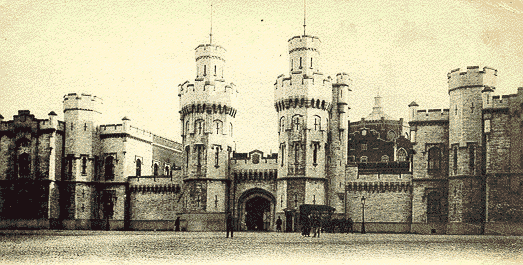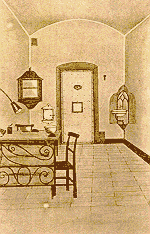
St. Gilles Prison Brussels.

Alfred Jones was not treated as a
British POW but like the others as a political prisoner. For eight
months he was detained in cell 75, in the next cell was a Belgian
lawyer Paul LURQUIN, they would speak through the wall and became firm
friends. They were kept in very poor conditions but LURQUIN believed
Alfred was in good health, they would while away the time with
imaginary betting on the horse and dog racing in the newspaper. Alfred
was also teaching LURQUIN English until he was taken to a different
cell in July 1942. Other prisoners gave him food from their Red Cross
parcels.
In St Gilles LANGLOIS and COPLEY were threatened with execution, having
been
taken in civilian clothes.There was also the matter of secret papers
found in LANGLOIS' possession containing information which had been
given to him by HUFKENS and hidden in the cake. The Germans must have
found them. COPLEY was kept in solitary confinement and so probably was
LANGLOIS. COPLEY felt heartfelt thanks to the anonymous guard who
managed to throw into his cell some tobacco and papers. They were taken
to Dulag Luft Oberuesel POW Camp on the 17th October 1941.
St-Gilles , still the main prison in Brussels , very overcrowded even
today. This is where all those arrested were taken.
The prison in 1944 is described in Marc Bles' book Child at War.
"It had five huge wings, three stories high, radiating from the
central hub. During the Second World War these were crammed with
prisoners. Apart from the run-of-the-mill criminal population, the
prison was overcrowded with political prisoners, the victims of German
oppression. There were men and women who had been in the resistance,
others suspected of resistance work, hostages for friends and relations
who had not been caught, who had done nothing at all and Allied
servicemen who were held for weeks before finally being shipped off to
POW camps in Germany. Prisoners would be taken into the courtyard and
the massive timber gates would be closed behind them. They lived in
small cells like bare stone caves standing off narrow cast-iron
galleries rising in tiers above the hard tiled floor. The prisoners
lived liked so many troglodytes in lofty , vaulted tunnels which rang
constantly with the sound of steel and smelt sickly of cabbage and
urine."
Harry Levy author of "The Dark Side of the Sky" tells me that he was in
solitary in
St.Gilles from about the 8th of August to 10th October 1942 "The ten
weeks I spent in St.Gilles , with the threat of concentration camp were
for me the blackest I have ever experienced" he writes.
 Harry LEVY was in St.Gilles from August to October 1942 he
says that the other prisoners spoke about the English soldier Joe
D****. They said he had been arrested in about March 1942. As a result
about 42 Belgians had been arrested by the Gestapo or the Geheime
Feldpolizei. Each time a man or woman was arrested Private X was
brought from the St Gilles prison to identify them. Later Harry LEVY
met and spoke to Private X in the queue to see the prison doctor. He
describes him as a young man of around 20 years old, a Londoner with a
broad cockney accent, short and slight of build with a pallid
complexion, black hair brushed straight back. He was clean shaven and
smartly dressed in contrast to the other prisoners. He tells Harry of
his reluctance to escape, he was having a too good a time in Brussels.
His Belgian helpers make him escape but he is captured at the French
border.
Harry LEVY was in St.Gilles from August to October 1942 he
says that the other prisoners spoke about the English soldier Joe
D****. They said he had been arrested in about March 1942. As a result
about 42 Belgians had been arrested by the Gestapo or the Geheime
Feldpolizei. Each time a man or woman was arrested Private X was
brought from the St Gilles prison to identify them. Later Harry LEVY
met and spoke to Private X in the queue to see the prison doctor. He
describes him as a young man of around 20 years old, a Londoner with a
broad cockney accent, short and slight of build with a pallid
complexion, black hair brushed straight back. He was clean shaven and
smartly dressed in contrast to the other prisoners. He tells Harry of
his reluctance to escape, he was having a too good a time in Brussels.
His Belgian helpers make him escape but he is captured at the French
border.
McCubbin was taken to Stalag VIG Bonne in March 1942.
JULY 1942
All three DELOGES and probably all the other Belgians remained in St.
Gilles Prison until July 1942 when they were taken to Germany. Alfred
Jones was probably taken to Germany in 1943, sometime before June. Joe
Dixie was sent to Stalag 344 in January 1943.